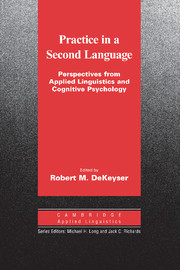Book contents
- Frontmatter
- Contents
- List of contributors
- Series editors' preface
- Introduction: Situating the concept of practice
- I: FOUNDATIONS
- Chapter 1 Input in the L2 classroom: An attentional perspective on receptive practice
- Chapter 2 Output practice in the L2 classroom
- Chapter 3 Interaction as practice
- Chapter 4 Feedback in L2 learning: Responding to errors during practice
- II: INSTITUTIONAL CONTEXTS
- III: INDIVIDUAL DIFFERENCES
- Conclusion: The future of practice
- Glossary
- Index
- References
Chapter 3 - Interaction as practice
Published online by Cambridge University Press: 27 January 2010
- Frontmatter
- Contents
- List of contributors
- Series editors' preface
- Introduction: Situating the concept of practice
- I: FOUNDATIONS
- Chapter 1 Input in the L2 classroom: An attentional perspective on receptive practice
- Chapter 2 Output practice in the L2 classroom
- Chapter 3 Interaction as practice
- Chapter 4 Feedback in L2 learning: Responding to errors during practice
- II: INSTITUTIONAL CONTEXTS
- III: INDIVIDUAL DIFFERENCES
- Conclusion: The future of practice
- Glossary
- Index
- References
Summary
Introduction
Research on interaction in second language acquisition points to the importance of a range of interactional processes in the second language learning process. These processes include negotiation for meaning, the provision of feedback, and the production of modified output, as well as cognitive (learner-internal) factors such as attention, noticing, and memory for language. Research on interaction is often applied in second language classrooms through corrective feedback practices and the use of communicative tasks, and it brings together a number of related processes. Accordingly, this chapter integrates several of the constructs and processes discussed independently in other chapters in this volume, most notably input (Leow), feedback (Leeman), and output (Muranoi).
The development of the interaction hypothesis
One of the innovations in second language (L2) work over the last 25 years has been the development of research into the cognitive mechanisms that underlie second language acquisition. Research into L2 interaction can be traced to several lines originating in the 1970s. For example, Krashen's (1978) formulation of the input hypothesis suggested that adult second language learning was driven primarily by exposure to sufficient amounts of comprehensible input – that is, input that learners can understand. These ideas represented a shift in thinking from earlier claims about language learning, such as those made by Lado (1957) whose contrastive analysis hypothesis emphasized descriptions of what learners might find more or less difficult to learn.
- Type
- Chapter
- Information
- Practice in a Second LanguagePerspectives from Applied Linguistics and Cognitive Psychology, pp. 85 - 110Publisher: Cambridge University PressPrint publication year: 2007
References
- 28
- Cited by



